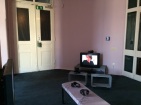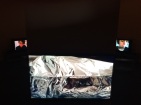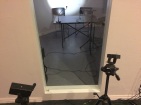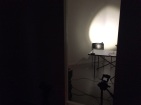Always Here For You: On ASMR, Autonomous Sensory Meridian Response
Claire Tolan
Published in the 2015 CTM Magazine
You can purchase limited copies at Motto Books in Berlin.

0.
ASMR, Autonomous Sensory Meridian Response, is a pleasant “tingling” sensation in the scalp and spine provoked by soft sounds such as whispering, nail-tapping, and hair brushing.
ASMR is an ephemeral experience. Like an itch, it disappears as it is followed. But somehow in the midst of the tapping, the whispering, and the tingling, the body relaxes. ASMR is touching the listener with quietness, soothing the listener with touch.

1.
The most popular platform for exploration and discovery of ASMR is YouTube. Millions of ASMR-triggering videos are posted, many with hundreds of thousands of views. The videos feature ASMRtists, the video creators, “performing” the sounds that trigger the tingling response, often in role plays.
The ASMRtist is speaking Korean, Spanish, Greek, French, Japanese, Russian, Hindi. The ASMRtist is a native English speaker blundering through a lesson on elementary German. The ASMRtist is peeling an orange, licking your ears, playing with water, pouring sugar, unwrapping a new hard drive. The ASMRtist is an abducting alien, an alpha-male, a personal trainer, a flight attendant. The ASMRtist is your hairdresser, your psychiatrist, your lover.
The ASMRtist is whispering in your ear that you are a wonderful person. It's hard sometimes, and we're all very exhausted. But you're doing the best you can. The ASMRtist tells you that she will always be here for you. Please, she says, try to relax. She is staring at you; her face is the frame. She leans back and slowly traces a circle on the tabletop with her long fingernails.

2.
Though rumors of forthcoming academic work circulate in many ASMR forums, there have been no scientific studies of the physiological effect published. ASMR is extra-institutional. Its name is a pseudoscientific string of euphemism [where Meridian = orgasm] and wannabe lingo. The reason that it has not been studied – and perhaps, prior to the hyperglossic hypochondria of the Internet, that it had not found a common name: it is as difficult to pinpoint in the brain as it is to describe in the body. It is finicky. Not everyone has it, and those who “get” it have different triggers. Sometimes it happens, and sometimes it doesn't. It's not easily reproducible; it's idiosyncratic; it's personal.
In recent years, there have been many news articles and exposés about ASMR. Most track the narratives of those who experience ASMR, focusing on early memories of the response, especially interviewees' discoveries that they are not alone in the reaction. This community revelation always seems to underline the discovery “that I'm not a freak.”
The bond of a shared sensation is somehow deepened by the intimacy of the sounds. Though ASMR content is remarkably diverse, one uniting factor is that the sounds are meant to provoke an intimate experience. They are close sounds, ones that seem as though they are nearly at your ears, the nape of your neck, your shoulders. Sounds that can only be perceived with proximity to the source. Your skin brushed, your scalp massaged, your ears cleaned. Your desk vibrating with the tapping of fingernails.

3.
The recording of ASMR sound is designed to maximise the illusion that the sounds are close to the listener. This is achieved with binaural recording, a technique in which microphones are positioned to mimic the placement of human ears. The resulting recording, when played through headphones, is a 360-degree uncanny soundscape, a spatialised splay of sounds layered on top of the ambient noise of the listener's environment.
Headphones allow the listener to perceive precise and quiet enveloping sounds. Headphones also sever the listener from her environment, creating a separate and solitary space in which the ASMR experience occurs. Any intrusion of the “real” room is read as noise.
4.
ASMR videos are often considered to be fetish performances. Unwitting viewers are caught off-guard by the closeness of the ASMRtist's face to the camera and fail to find her simulated intrusion into personal space pleasurable. This is weird, the discussion goes, so it must be someone else's fetish. This is weird, so someone must be getting off on this.
It's true that sometimes the videos are deliberately erotic. Here, the camera is zoomed in on her chest, his crotch. Here the title “[ASMR]妹の悪戯 Little sister licks your ears [Eng-Sub]” plays atop an illustration of a pale pink tongue licking a finger – no video needed.
More often, though, viewers perceive sexual content where the ASMRtist did not intend it. Whispering, one viewer thinks, draws attention to the mouth. Affirmation and care-taking mimic mothering. It's easy to make these connections if you want to make them. To the excited observer, the quiet movements of the ASMRtist seem to be building like the eroticism of a horror film. Fingernails trace slowly over bare skin. But there is no climax. The experience ends in a clean grid of YouTube related video recommendations. Must any staged act of intimacy by a stranger qualify as erotic?
More than anything, the videos transmit something that is like presence. The content is a vehicle for experience.

I'm leaning towards you on a sofa. Fingers brushing brocade. Feet scraping wooden floor. I'm sorry you find it uncomfortable to have my face so close to yours. Let me pull back a bit until you feel more at ease.
5.
ASMR videos are meant not only to trigger the tingling response, but also to soothe, to relax, to affirm. The videos are created as treatments for an array of chronic contemporary ills – anxiety, depression, insomnia. This is established both by video titles (“ASMR – Affirmation – Soft whispering, Confidence-boosting” or “Guided Meditation – ASMR – Bad Day”) and in the comments left by viewers, some of whom state that certain videos act as nightly sleep aids.
If it is true that an individual is rarely mentally ill, but instead a representative of a larger societal sickness, we can see these afflictions as the products of advanced capitalism, or, per Zygmunt Bauman, liquid modernity. Bauman has written extensively about the surveillance apparatus within liquid modernity, which preemptively accuses in order to avoid what might happen. Thus, we stand always already accused, in violation, apprehended. Mass surveillance watches all with the supposition that there is a reason to watch (i.e. coming guilt). This double bind – simultaneously being told you are doing fine and condemned as having done wrong – provokes the kind of anxiety sutured by ASMR.
The millions of mundane bits of everyday life funneled through the surveillance apparatus recall the banality of ASMR content. Like an analyst, you watch small moments and movements. Can you spot a pattern before the tingling makes you catatonic? Does the analyst, wearing headphones at her desk, ever feel an unsettling sensation in her scalp, a slow relaxation?
In ASMR videos, you are asked feel at ease in a place where you will never belong. You are greeted by a stranger who is at the same time welcoming thousands of other viewers. You – and the others – participate in a simulated intimacy that is aware of – and effective because of – its pretense. You are a subject interpellated by the ASMRtist. But you are also a voyeur, a distant stranger gazing into the ASMRtist's home. You wrestle between the roles; you play the game.
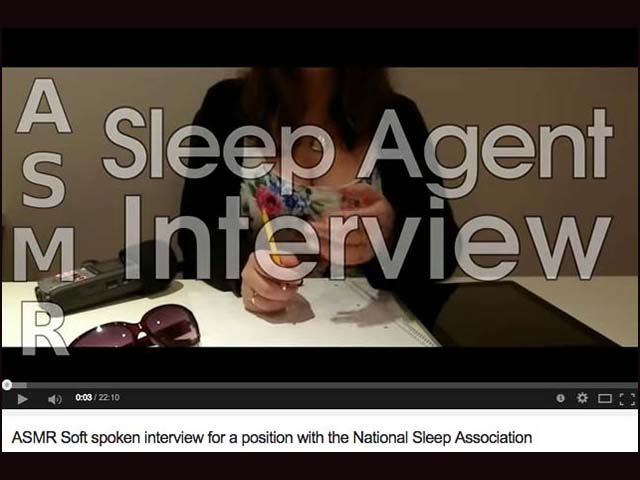
In the first half of this role play, you watch me, and I pretend like I don't know you're watching. In the second half, we pretend that I'm you and you're me. You're watching me, but I don't know you're watching.
6.
How do you situate the fringe Internet therapy of ASMR in a larger healing tradition? Beyond its obvious counterparts in the realm of alternative medicine, I often wonder about the relationship between the remote, anonymous touching of ASMR and the attention delivered by a medical professional. A physical therapist, a masseuse, a nurse. So much of what medical professionals give goes beyond targeted treatment. A friend writes me about bathing an elderly patient at the hospital. “Don't be afraid to really scratch my scalp,” the patient said. “Scratch it like it was your own.”
Does it matter whose hands – and does it matter who the touch is intended for – if the touch finds the right spot? Does it matter who is telling you to forget about your awful day and relax if in the end you find sleep?
In some articles, psychologists worry that people are going to begin relying on the videos for momentary distraction instead of seeking “real” solutions to their problems. This reading seems far too easy, especially when the “real” solutions are usually pills, and health insurance often does not cover psychological treatment (if insurance is available at all). It's too easy when ASMR videos aren't destructive in the way that a lot of other coping mechanisms (alcohol, drugs) are.

I'm not saying that ASMR provides some sort of panacea containing the secrets to surviving (and transcending!) advanced capitalism. But can something be found lying latent in these long, slow, soft landscapes of sounds, made to touch and to soothe, that might be a lever for some sort of transformation? Could the videos contribute to new fantasies? New imaginaries? New critiques? If a stranger can touch you with her voice, what then? And after watching someone move marbles on a granite table for an hour, what can be found in the pit of that boredom?
The hot tub jets are bubbling. What's that? Yeah, of course. I'll always be here. I'm happy to wait. Come on in whenever you're ready. The water's warm.

7.
In ASMR videos, the quiet everyday is elevated into the position of spectacle. A friend watches an ASMR video of someone peeling an orange. Days later, she writes to say that she was peeling an orange and experienced ASMR, something that had never happened to her before. The sounds, once they are identified as triggers, are connected in memory with the reaction. They are relearned as extraordinary.
ASMR is a response to quietness, which, in turn, allows us to process quietness in a new way. Prompted by Rosi Braidotti's wonderful writing on the post-human, I have begun framing my thoughts with a passage from Middlemarch by George Eliot:
“That element of tragedy which lies in the very fact of frequency, has not yet wrought itself into the coarse emotion of mankind; and perhaps our frames could hardly bear much of it. If we had a keen vision and feeling of all ordinary human life, it would be like hearing the grass grow and the squirrel's heart beat, and we should die of that roar which lies on the other side of silence. As it is, the quickest of us walk about well wadded with stupidity.”
ASMR is a leak from the other side of silence. It prompts the relearning of sound as sensation and the soft as spectacle. What happens as it infiltrates our “wadding”? If we follow the rivulets draining down through the packaging, how do they run and to what low ground? How are they subsumed by our known sensorium?
I'm removing the plastic wrap from a new paper towel roll. I pause for a moment.
I'm recording this at my friend's house, which is right next to the interstate. I'm in the bathroom at the center of the house, but you can hear the traffic. I hope that doesn't bother you. I'm so glad you're taking some time for yourself right now. I hope you're able to relax. You really, really deserve it.
I finish removing the plastic. I tear off a section of paper towel. I hold it up to the camera. Your screen becomes white. The embossed diamond patterns on the towel appear, in two dimensions on your screen, a light gray.
For several minutes I hold the towel in front of the camera, stroking it. And then: do you want me to tear the paper today or should I crumple it up? It's your choice. I'll do whatever you want. Click here to watch me tear the paper. Click here to watch me crumple it. Click here to restart.

Photo Credits
DianaDew ASMR / ♥ Gentle hands and tapping nails on mirror ♥ whispered ASMR ♥
Heather Feather / Candy Queen ASMR Role Play For Relaxation (ASMR) (3D Binaural)
Tony Bomboni (ASMRer) / Professional 3D Scalp Check For Lice & Scalp Massage with Chopsticks (ASMR)
JustAWhisperingGuy / ASMR Binaural Ear Touching for Sleep and Relaxation
kingmanekin / [ASMR]妹の悪戯 Little sister licks your ears [Eng-Sub]
Lady Bug ASMR / ASMR Soft spoken interview for a position with the National Sleep Association
MimiTingles / ASMR Glass stones/marbles sounds - No whisper
nana kim / Korean Asmr: How to peel an orange(한국어 ASMR : 귤 까는 방법)
stereoasmr / ASMR paper towels


